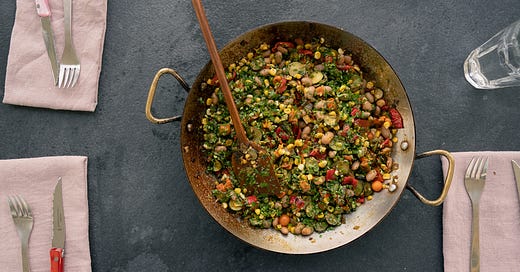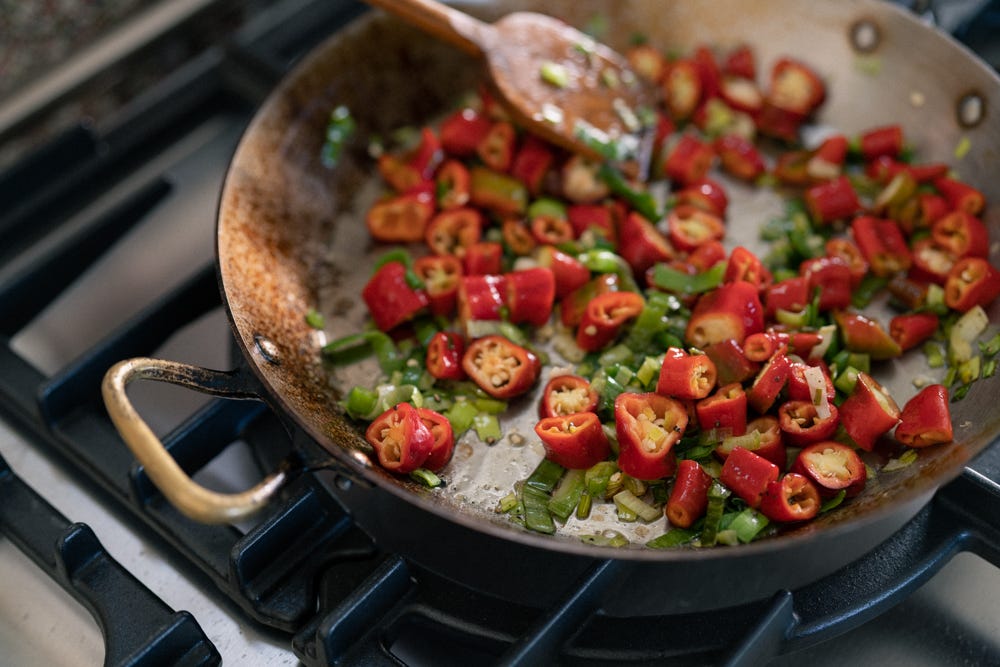SUCCOTASH
A note on the subscription - my newsletter is still free for all, but I would encourage anyone who is reading to subscribe for $2/month. If you are a free subscriber you can change to paid by clicking the “subscribe now” link below.
Thank you for reading! Please share with friends and family!
This month I’m sharing a recipe for succotash, a super straightforward vegetable dish that, to me, is one of the best things to eat in the summer (other than maybe a tomato and mayonnaise sandwich).
There is no standardized way to make succotash. If you look online there are probably hundreds of recipes that have very little in common with one another. The dish has its roots in Native American cooking, and the only sort of “rule” is that it generally includes beans, corn and squash, otherwise known as the three sisters, which, when planted together, offer each other symbiotic growing conditions.
I know succotash as a Southern dish - from my mom’s Virginian side of the family - which often includes bacon and butter beans or lima beans. I made the base recipe vegetarian, but the addition of bacon is very, very delicious.
As has come to be the case for each of my recipes, this month’s is incredibly versatile, and should serve as another lesson in being mindful while cooking. Slow down a bit and ask yourself - What am I doing and why am I doing it? What is the best way and size to cut each vegetable? Do the sizes match each other so they all fit together in one bite? In what order should I add each vegetable to the pan so none are over or under-cooked? Are things cooking too hot and fast, or is there not much action going on in the pan? Should I turn the heat up or down to accommodate for what I’m seeing and hearing? Asking yourself questions like these will help to make you a better cook.
A few notes on ingredients -
Jimmy Nardello peppers - OMG I am completely in love with jimmy nardellos. They are the best version of any sweet pepper I could ever imagine. Silky, meaty flesh. Deep pepper flavor. If you see them at your local market, buy them! They are perfect grilled, or I’ll sometimes make a sort of breakfast potato hash by frying them in a bit of butter with onions and par-boiled potatoes.
Dried beans vs. canned beans - I promise you, there is absolutely no competition. Canned beans kind of suck and are under-seasoned and impossible to fix. Cooking beans from dry will always be more delicious than canned. If you forgot to soak beans for your succotash, just leave them out!
Wonderful photos again courtesy of Ben Turner, whose work you can find here.
SUCCOTASH serves 4-6 as a side dish
3 tablespoons butter
1 tablespoon olive oil
BACON OPTION - instead of the butter + olive oil use the rendered fat of 6-8 slices of bacon, cut into 1/4 inch strips
3/4 cup leek, well washed and sliced into 1/4 inch half moons (roughly one small leek) (spring onion, shallot or onion all work well here as well)
1 1/2 -2 cups jimmy nardello peppers, sliced into 1/2 inch rounds (also could use shishitos, sweet Italian peppers, or any other sweet pepper)
Optional - 1 jalapeno, sliced into 1/8 inch rounds or half moons, or diced
1 1/2 - 2 cups zucchini, sliced into 1/4 inch rounds or half moons depending on the size (roughly 2 medium or 4 small zucchini)
1 pint whole cherry tomatoes, stems removed
2 ears corn, kernels cut off the cob
1 1/2 cups cooked beans 1 - I used dried cranberry beans, but butter beans, cannellini, flageolet, chickpeas, black beans, or frozen lima beans would be great, too
Vinegar to taste - I used my favorite, moscatel, but any vinegar would work here
Salt + pepper to taste
½ cup chopped herbs - I used parsley, chives and basil, but pretty much any tender herbs would be great - cilantro, tarragon, dill, chervil, scallions, etc.
If using bacon, add 1/4 inch strips to a wide and shallow sauté pan (around 12-14 inches) (or a dutch oven of the same width would work, too) and set to medium-low heat. I like to start bacon in a cold pan because this allows the fat to render more slowly and evenly. Allow bacon to slowly render until it becomes golden and crispy, about 8-10 minutes. Spoon out the crispy bacon onto a plate, trying to leave all the fat behind. Set the bacon aside for later. Then add leeks and continue on as follows…
If not using bacon, add the butter and oil to your pan, set to medium-low heat, and add the sliced leeks. Season with salt and pepper. Cook leeks for 2-3 minutes to soften. We don’t want any color here, so if the pan is too hot you can reduce the heat to low.
Next, add the sliced peppers, season with a bit more salt, and cook until they are softened, about 5-8 minutes. You can add the jalapeno with the peppers if using.
Add the sliced zucchini, a bit more salt, and sauté for 3-4 minutes until just softened.
Now add your whole cherry tomatoes. Turn up to med-high heat. We want the tomatoes to blister and burst slightly so that they release some of their juices. We are not looking to make sauce, though, so just cook for a few minutes. If you notice that things are starting to brown or scorch, add a little water, maybe 1/4 cup, to prevent any caramelization.
Once the tomatoes have started to blister and you see the skins breaking apart, add the corn, cooked beans, and a splash of vinegar. Cook everything together for 2-3 minutes. Now taste - does it need more salt, or pepper, or vinegar? When the succotash tastes delicious turn off the heat and add your chopped herbs. Now is the time to sprinkle over your reserved crispy bacon if you’re using it!
Serve with rice or any protein - fish, roast chicken, a grilled pork chop, anything! It would be delicious for breakfast with some eggs, too.
How to cook beans from dry:
1/2 cup dried beans will generally yield 1 1/2 cups cooked beans.
Start by soaking dried beans in plenty of water overnight. The next day, drain the beans and place in a pot, covered by about 6 inches of fresh water. Bring to a boil, then reduce to a low simmer. It’s impossible to predict how long dried beans will take to cook, it really depends on their age. I generally start checking after about 30 minutes. Once the beans are about three quarters of the way done, I salt the water pretty heavily, maybe a couple tablespoons for this amount of beans. You want the liquid to be well seasoned so that the beans can become well seasoned, too. Salting in the last quarter of cooking allows the beans to become seasoned all the way through before they over-cook and begin to fall apart. Most cooks agree that salting beans too early in the cooking process causes them to become tough, although I’ve heard that this is a myth. I have yet to confirm this, so I always salt at the end. Maybe I’ll test that in a future newsletter…
It’s best to store the beans in their cooking liquid for the most plump and delicious results.












